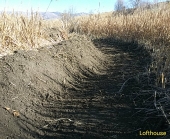




 4
4
 2
2




J Hampshire wrote:
We currently rent and don't plan to be here in another couple summers.





 3
3




 5
5




J Hampshire wrote:We currently rent and don't plan to be here in another couple summers. The question is; would double digging all of this, or dare I say, rototilling ONCE to get the "flywheel" moving, be a viable option? In the interest of expediency, is "one till" something to consider; but from there rely completely on permaculture/no till/soil food web ideologies...?
 2
2




...and at dollar store they're practically giving seeds away.

 2
2




J Hampshire wrote:My wife and I were elated to start our first garden a few weeks ago. Sprouted everything in soil blocks per Eliot Coleman and it all looked phenomenal. Then we decided to try sort of cross-breed with sheet mulching and back to Eden; ever since we heard that double digging was colloquially referred to as "bastard trenching". Tried a layer of newspaper, then compost, then wood chips. Dug down to below the grass layer and planted. Everything is dying or dead. Since everything is going to shit, I decided to double dig a section of one of the two beds... A very small section. They nicknamed it BT for a reason. This soil is not nearly as nice as I had originally thought. It's VERY clay/sandy with a pretty staggering amount of rocks. The plants might as well be in thimbles. Even the stuff I double dug isn't going to make it. But that could be from the shock. We have hopes that in the next year or two, this will be fruitful soil given the time. The worms are already quite abundant in the top two inches. I know lasagna/back to Eden are really about the long term, but we gave it a shot, just to see.
We currently rent and don't plan to be here in another couple summers. The question is; would double digging all of this, or dare I say, rototilling ONCE to get the "flywheel" moving, be a viable option? In the interest of expediency, is "one till" something to consider; but from there rely completely on permaculture/no till/soil food web ideologies...?
 3
3




 2
2




 2
2




Tilling even once destroys all the work the microorganisms have done, in some cases that means all the work that's been done over millions of years. Tilling once and you never get it back.

 1
1




 3
3




J Hampshire wrote:My wife and I were elated to start our first garden a few weeks ago. Sprouted everything in soil blocks per Eliot Coleman and it all looked phenomenal. Then we decided to try sort of cross-breed with sheet mulching and back to Eden; ever since we heard that double digging was colloquially referred to as "bastard trenching". Tried a layer of newspaper, then compost, then wood chips. Dug down to below the grass layer and planted. Everything is dying or dead. Since everything is going to shit, I decided to double dig a section of one of the two beds... A very small section. They nicknamed it BT for a reason. This soil is not nearly as nice as I had originally thought. It's VERY clay/sandy with a pretty staggering amount of rocks. The plants might as well be in thimbles. Even the stuff I double dug isn't going to make it. But that could be from the shock. We have hopes that in the next year or two, this will be fruitful soil given the time. The worms are already quite abundant in the top two inches. I know lasagna/back to Eden are really about the long term, but we gave it a shot, just to see.
We currently rent and don't plan to be here in another couple summers. The question is; would double digging all of this, or dare I say, rototilling ONCE to get the "flywheel" moving, be a viable option? In the interest of expediency, is "one till" something to consider; but from there rely completely on permaculture/no till/soil food web ideologies...?







 1
1




R Ranson wrote:Good for you, practicing your forever skills in a tempory place. So many times I've seen people come to farming/growing food with zero experience and expect it to be all sunshine and rose coloured tomatoes. Like hell it is! Do what you can where you are. Improve the soil. Learn how to do everything wrong. In the end, the place is better than when you started and you know how to overcome that hurdle in future. Show 'em that you care in spite of it being a rental property.












 1
1




List of Bryant RedHawk's Epic Soil Series Threads We love visitors, that's why we live in a secluded cabin deep in the woods. "Buzzard's Roost (Asnikiye Heca) Farm." Promoting permaculture to save our planet.




John Elliott wrote:
J Hampshire wrote:
We currently rent and don't plan to be here in another couple summers.
Then you've come to the wrong board, you want Tempies.com, where they talk about tempaculture.
 1
1




Earthworks are the skeleton; the plants and animals flesh out the design.

|
I like tacos! And this tiny ad:
Homestead Pigs Course
https://permies.com/wiki/365748/Homestead-Pigs
|




